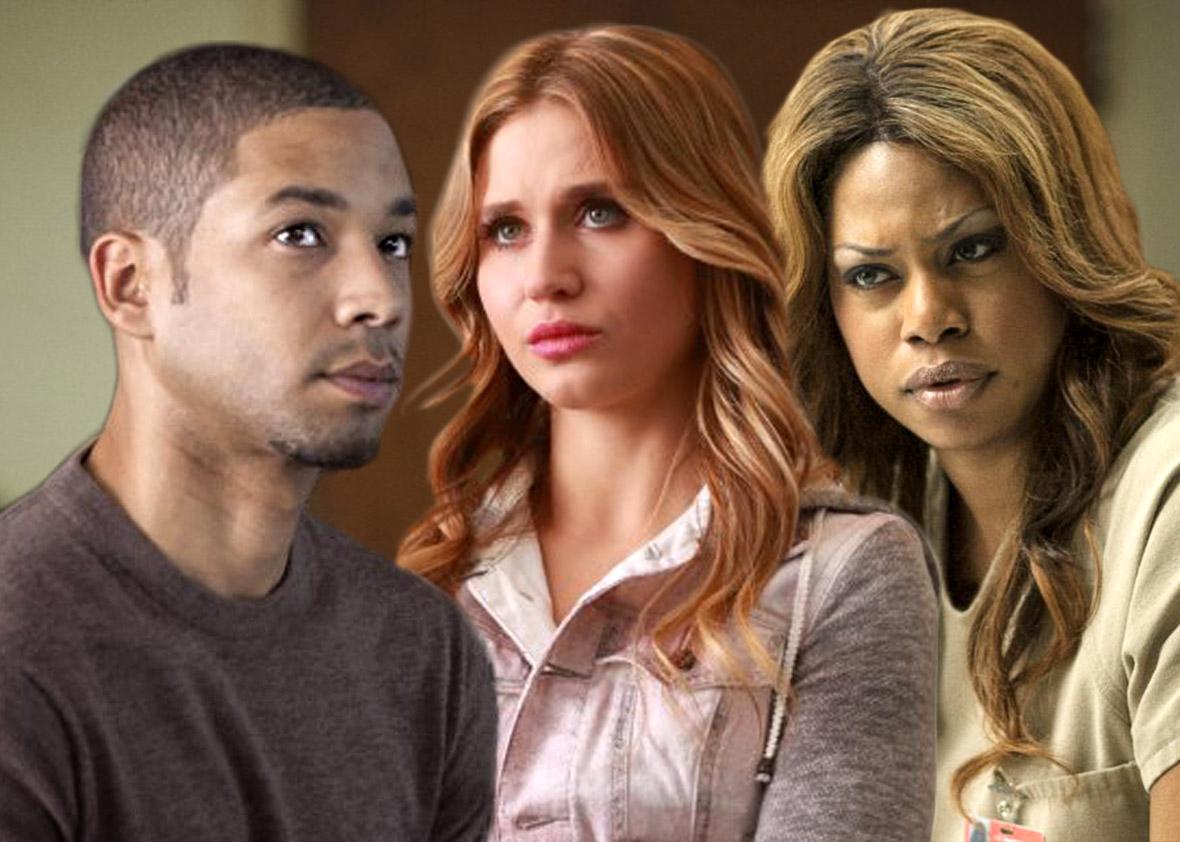I am not the intended audience for GLAAD’s annual “Where We Are on TV” report, the 2015-16 edition of which is released today. It’s my job—part of it, anyway—to report on and critique the way LGBT characters are represented in pop culture, so I pay close attention to TV’s gay characters and story lines. Consequently, when I read a GLAAD publication, I’m more likely to nit-pickingly find fault with its conclusions than to use it to learn about a queer plot line I wasn’t aware of. It’s possible, then, that I’ve greeted earlier “Where We Are on TV” reports with a less magnanimous response than they deserved. In the spirit of trying to do better, I’ll hold my quibbles until after I’ve shared a few of the findings from the new report, which forecasts the expected presence of LGBT characters on scripted shows that will air in primetime between June 1, 2015, and May 31, 2016.
According to GLAAD, 35 of the 881 series regulars on the broadcast networks (ABC, CBS, the CW, Fox, and NBC)—4 percent—will be LGBT, up from 32 last year. The primetime broadcast lineup will also include 35 recurring characters. (Frustratingly, GLAAD doesn’t offer a definition of “regular” and “recurring,” although the terms are used throughout the report.) Gay men make up the majority of broadcast’s queers at 47 percent (33 characters), though lesbians increased five points from 2014 to 33 percent (23 characters). Bisexual representation rose two percentage points, and there are now 12 bisexual women and two bisexual male characters on network shows, but no transsexuals.
Over on cable, 84 regular LGBT characters are promised, up from 64 last year, along with 58 recurring characters, compared with just 41 last year. Gay men also dominate on cable, making up 41 percent of the made-up LGBT people, while 22 percent are lesbians, 23 percent bisexual women, 13 percent bisexual men, 1 percent transgender women (two characters), and 1 percent transgender men (one character).
This year, for the first time, GLAAD also kept track of LGBT characters on the original programming from streaming providers Amazon, Hulu, and Netflix, finding 43 regular LGBT characters and 16 recurrers. Gay men still came out on top, but more narrowly: They were 39 percent of the LGBT characters, while lesbians made up 36 percent, bi women were 15 percent, bi men 5 percent, and transgender women—one of whom was also a lesbian—made up 7 percent.
If you’re still reading this, you must be a CPA, a fantasy football nerd who took a wrong turn, or a GLAAD staffer. I yield to no one in my love of LGBT-themed television, but character counts and stats about the percentage of queer characters on streaming services who are gay men aren’t what get my engines revving. I’m interested in learning which shows—be they on broadcast, cable, streaming, or beamed in from outer space—have interesting and innovative queer storylines. I’m curious about series that take surprising turns, like CBS’s Person of Interest, where two female characters who had previously presented as straight realized they were attracted to each other. And I have an urgent need to make sure that people who pay a little less attention to this kind of thing than I do know that they should check out Sense8, Transparent, The Fosters, and Mr. Robot. (In this context, check out means “block out enough hours to watch these shows in their entirety if you haven’t already.”)
Unfortunately, “Where We Are on TV” doesn’t function very well as a method of discovering queer-friendly shows, because the report doesn’t show its work: Although we learn that there are 33 gay male characters on network primetime, there’s no way to see who’s on that list. GLAAD used to supply this information—here’s the roster from the 2011-12 report—but a spokesman told me that since news that characters are LGBT might sometimes constitute a spoiler, some shows provide casting information confidentially, which means GLAAD isn’t able to make it public. (As someone who once pointed out that an earlier “Where We Are on TV” gave away not-yet-revealed plot twists, I’m in a bad position to complain about this, but the lack of transparency does make the report a lot less useful—and less checkable.)
My statophobia notwithstanding, “Where We Are on TV” is an impressive piece of work. In addition to keeping track of LGBT representation, its authors also crunched the numbers on TV’s gender balance and on representation of black, Latina/o, Asian and Pacific Islander, bi, and trans characters and of people with disabilities. But as the organization indicated in September, when it announced that it would no longer be compiling its Network Responsibility Index, GLAAD is gradually de-emphasizing its focus on counting. As CEO and president Sarah Kate Ellis notes in her introduction to the new report:
[I]t’s important that television characters reflect the full diversity of the LGBT community. It is not enough to just include LGBT characters; writers must craft those characters with thought and care. They must reject harmful, outdated stereotypes and avoid token characters that are burdened with representing an entire community through the view of one person.
The success of shows like Empire, Transparent, and Orange Is the New Black is the likeliest guarantee that more programmers will create storylines that feature diverse, fully rounded LGBT characters. GLAAD’s spreadsheet ninjas deserve a round of applause—but as Ellis notes, “numbers only tell part of the story.” We mustn’t overlook the rest of the challenge.
